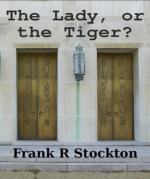
|
| Name: _________________________ | Period: ___________________ |
This test consists of 15 multiple choice questions and 5 short answer questions.
Multiple Choice Questions
1. What artistic movement influenced Frank R. Stockton and other authors during his time period?
(a) The Dadaists.
(b) The Modernists.
(c) The Cubists.
(d) The Pre-Raphaelites.
2. What aspect common to children's stories did Frank R. Stockton avoid in his writing?
(a) Archetypes.
(b) Irony.
(c) Satire.
(d) Moralizing.
3. What is the king said to be greatly given to in the beginning of the story?
(a) Self-communing.
(b) Consulting his cabinet.
(c) Holding seminars.
(d) Adorning his wife with jewels.
4. What does the word "wend" mean in the narrative?
(a) To go or leave.
(b) To compose.
(c) To write.
(d) To sing.
5. How does the narrator describe the audience in the case where a criminal is killed in the arena?
(a) "With poetic songs of freedom."
(b) "With merry laughter and dancing."
(c) "With rapturous cries of justice."
(d) "With bowed heads and downcast hearts."
6. What literary word refers to a typical example of a certain person or thing, such as the characters in "The Lady, or the Tiger?"
(a) Proscenium.
(b) Antagonist.
(c) Parable.
(d) Archetype.
7. How are the passages of the amphitheater described in Part 2?
(a) "Steel-walled."
(b) "Glass-walled."
(c) "Unseen."
(d) "Visible."
8. Of the criminal facing trial in the arena, the narrator says that he is subject to no guidance "but that of the aforementioned" what?
(a) "Clues indicated from the masses."
(b) "Riddle depicted by the jester."
(c) "Impartial and incorruptible chance."
(d) "Letter from the king."
9. In what tense is the story related?
(a) Present tense.
(b) Future tense.
(c) Past tense.
(d) Passive future tense.
10. How are the galleries of the amphitheater described in the story?
(a) "Encircling."
(b) "Below the stage."
(c) "Linear."
(d) "Above the stage."
11. How are the doors that the criminal must choose from described in the narrative?
(a) Exactly alike.
(b) White and black.
(c) Round and square.
(d) Blue and red.
12. What does the word "idealism" refer to in the narrative?
(a) The belief in government.
(b) The pursuit of high or noble principles.
(c) The study of governance.
(d) The belief in God.
13. What is described behind one of the doors in Part 2 of the narrative?
(a) The king.
(b) A tiger.
(c) A judge.
(d) A jester.
14. What does the word "incorruptible" from the story mean?
(a) Allegorical.
(b) Stringent.
(c) Everlasting.
(d) Metaphorical.
15. What style does "The Lady, or the Tiger?" mimic?
(a) That of a fairy tale.
(b) That of a Greek mythological tale.
(c) That of a Biblical tale.
(d) That of a horror story.
Short Answer Questions
1. How are the king's "subjects refined and cultured," according to the narrator?
2. What do the hired mourners do if the criminal on trial is killed?
3. With what genre is "The Lady, or the Tiger?" associated?
4. Of the king, the narrator says in Part 2 that he "knew no tradition to which he owed more allegiance than" what?
5. How are the distant neighbors described that helped to polish the king's ideas?
|
This section contains 504 words (approx. 2 pages at 300 words per page) |

|




